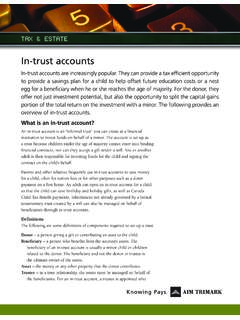Transcription of Rebuilding the U.S. Refugee Admissions Program (USRAP ...
1 Rebuilding the Refugee Admissions Program (USRAP): Recommendations to Strengthen Refugee resettlement in the United States March 2022. The need for long-term protections for refugees has never been greater. The world is facing record displacement figures of more than 84 million people forced from their homes with enormous Refugee overseas assistance needs. Of those, there are more than 31 million refugees, million of whom are in need of resettlement , but fewer than 1% of refugees will ever be resettled to a third country. In 2021, most new refugees came from five countries: Central African Republic, South Sudan, Syria, Afghanistan, and Nigeria. Further, the escalation of conflict in Ukraine has triggered an immediate and steep rise in humanitarian needs with millions of refugees who fled Ukraine since February 2022.
2 The resettlement Program sustained devastating cuts and in 2021 Refugee resettlement in the United States fell to its lowest level since Congress created the modern system in 1980. Today, resettlement agencies are beginning to rebuild the Refugee Admissions Program (USRAP) at a time when they are simultaneously continuing to resettle Afghan evacuees. The must both rebuild and strengthen the resettlement Program and mobilize the public resources required to do so. It is critical that the Biden administration offers bold leadership to restore global leadership in Refugee protection, as it promised in the February 2021. Executive Order. We offer the following recommendations to turn this vision into a reality: 1. Expedite Family Reunifications: Refugee families face extreme backlogs in both the follow- to-join (FTJ, I-730) and Priority 3 (P-3) processes, and families continue to face protracted separation.
3 Reforms to the Refugee family reunification process should include immediately prioritizing staffing and resources to identify and remove bottlenecks to expedite existing FTJ. and P-3 cases, removing the two-year filing deadline for FTJ petitions, and reducing lengthy delays in USCIS's Refugee Access Verification Unit (RAVU) initial paper review of claimed relationships between the anchor relative and overseas family member listed on the Affidavit Of Relationship (AOR). 2. Expand Overseas Refugee Adjudication Capacity: To meet urgent protection needs and to resettle as many refugees as possible in FY 2022 and FY 2023, the administration must strengthen adjudication capacity to increase the number of refugees we can process to the United States.
4 This should include hiring and training additional USCIS Refugee officers, increasing the number and duration of circuit rides with trained staff, scheduling robust circuit rides as soon as possible for FY 2023, expanding resettlement Support Center (RSC) capacity, (re)opening international offices, and expanding the USRAP pipeline to include additional NGO. and DOS Embassy referrals. For example, the administration should expand all potential processing locations for refugees whose RSC is not operational due to emergencies or where processing has stopped, such as by creating pop-up RSCs. 3. Improve Refugee Vetting Efficiencies: Tens of thousands of refugees referred to the USRAP have languished in dangerous conditions for years, while they wait with little information about the status of their case.
5 The administration should enable more efficient and equitable screening and adjudication processes, such as by expanding the use of video technology, reversing harmful and ineffective vetting practices, and establishing oversight mechanisms and high-level coordination of all aspects of USRAP. Particular attention should be paid to backlogs, such as applicants who had been previously interviewed before 2020, Afghan and Iraqi Special Immigrant Visa (SIV) applicants, Iraqi and Afghan P-2 applicants, and family reunification cases, such as P-2 Iraqi and Syrian I-130 beneficiaries. 4. Strengthen Domestic resettlement Capacity: Attention to domestic capacity is urgently needed to ensure that the administration can scale resettlement in FY22 and FY23.
6 PRM and ORR should take steps to increase capacity across the network of resettlement agencies. Reforms could include providing additional funding for staffing, housing, and integration services for refugees and reforming the funding structure to ensure guaranteed funding for resettlement agencies at the beginning of the fiscal year. The administration should include creative capacity expansion, such as through new and existing community sponsorship programs. 5. Ensure Due Process and Transparency: Transparency and public reporting are critical to holding the administration accountable for operating USRAP in good faith and providing Refugee applicants with more equitable treatment. The administration should reduce the opacity with which USRAP operates, such as by providing more regular case updates for applicants, continuing to publish reviews, reports, and policies relevant to Refugee processing, and allowing access to counsel for key aspects of Refugee processing.
7 The administration should further ensure that it conducts timely and meaningful consultations with Congress around the FY 2023. Refugee Admissions goal in summer 2022 and sign the FY 2023 Presidential Determination before September 30th. 6. Appoint Senior-Level White House Coordinator: The White House should appoint a senior-level coordinator with a high level security clearance to coordinate federal agencies and other stakeholders around Refugee resettlement and establish specific benchmarks to meet Admissions goals. The President should establish an advisory body on Refugee protection, led by the White House coordinator and composed of leaders and experts, including a significant number of refugees, former refugees, asylees, stateless people, and other vulnerable migrants.
8 Continuing to rebuild this life-saving Program will take time, resources, coordination, and leadership.





